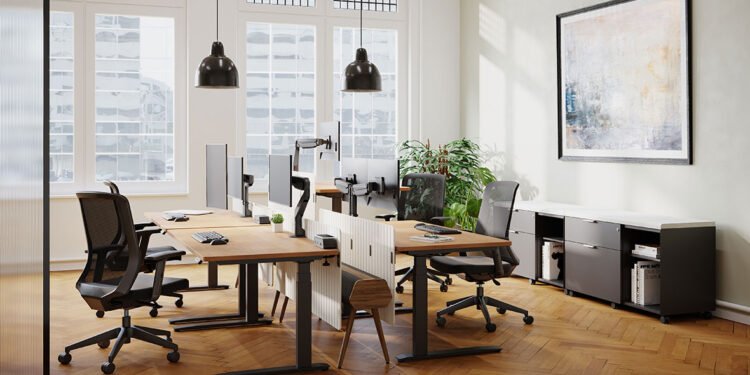Introduction to Ergonomics
Office ergonomics is not simply a catchphrase, it is an essential component of creating work environments that support productivity and well-being. In a nutshell, ergonomics is about optimizing the environment to fit the people who use it. This field of study focuses on reducing strain, preventing injuries, and improving productivity. With businesses increasingly focusing on employee well-being, many are investing in ergonomic solutions, including home office storage options that streamline workspaces and reduce clutter.
One resource, Verywell Health, suggests that common ergonomic principles involve fitting the job to the worker and not the other way around. By understanding ergonomic fundamentals, both employers and employees can create environments that support prolonged productivity and general well-being. This involves tweaking various aspects of the workspace to reduce physical strain and adapting tasks to meet individual physical requirements.
Benefits of Ergonomic Workspaces
Investing in ergonomic solutions offers numerous benefits. A thoughtfully designed workspace can significantly reduce common workplace injuries such as back pain, repetitive strain injuries, and eye strain. An optimized ergonomic environment aims to create the most comfortable and efficient setting, thereby preventing the musculoskeletal disorders often found in office settings.
For instance, the Centers for Disease Control and Prevention (CDC) notes that ergonomics can lead to healthier work environments, which translate to happier and more productive employees.
Moreover, ergonomically optimized workspaces can enhance concentration, increase productivity, and boost morale by creating a more comfortable and supportive work environment. This holistic approach ensures that employees feel valued and can perform their tasks without the unnecessary distractions caused by discomfort or pain. The implementation of ergonomic solutions can also reduce absenteeism due to work-related injuries and improve overall job satisfaction.
Essential Ergonomic Equipment
- Adjustable chairs with lumbar support.
- Desks that accommodate both sitting and standing positions.
- Monitor stands to position screens at eye level.
- Keyboard and mouse pads that reduce wrist strain.
These pieces of equipment are fundamental in crafting a workspace that prioritizes health. For example, an adjustable chair that supports the lower back can prevent chronic back pain, while a standing desk offers the flexibility to alternate between sitting and standing, reducing the risk of prolonged sedentary behavior. A proper monitor stand helps keep the screen at eye level and reduces neck and shoulder strain. In addition, integrated wrist supports on mouse and keyboard pads can be quite helpful in preventing strain and injury. Integrating these items into an office space forms the basis of a robust, ergonomic setup that can significantly improve the physical comfort of employees.
Ergonomic Desk Setup
Creating an ergonomic desk setup involves a few key adjustments:
- Chair Heights: Ensure your feet are flat on the floor with knees at a 90-degree angle.
- Monitor Level: Set your monitor’s top to be at or slightly below eye level.
- Keyboard and Mouse: Keep them at a height where your elbows are at a 90-degree angle and your wrists are straight.
These adjustments can seem minor but have significant long-term impacts. Proper chair height ensures that you are not straining your knees or feet, while an appropriate monitor level helps prevent neck and eye strain. The correct placement of your keyboard and mouse further minimizes the risk of developing repetitive strain injuries like carpal tunnel syndrome. By adhering to these straightforward recommendations, employers can foster a work climate that reduces the likelihood of physical illnesses among their staff, resulting in happier and more productive workers. Regularly reviewing and adjusting these elements can help maintain an optimal ergonomic environment.
Training and Education
Even the best ergonomic setups can be underutilized without proper training. It’s vital to educate employees on the importance of posture and how to use ergonomic equipment correctly. Regular training sessions can help reinforce good habits and raise awareness about the benefits of ergonomics. For many employees, sitting with correct posture or adjusting desk equipment might not come naturally. Education on these points is crucial to ensure ergonomic benefits are fully realized.
Training should include information on proper seating posture, desk setup, and the use of ergonomic equipment. Additionally, to help reduce the hazards connected with prolonged sitting or repetitive motions, it’s beneficial to teach staff easy stretches and exercises they can perform throughout the day. Workshops, informational sessions, or even brief monthly reminders about ergonomic practices can help maintain a culture focused on health and well-being. Reinforcing these practices periodically ensures that employees remain conscious of their workspace setup and habits, leading to a sustained positive impact on their health.
Tracking Progress and Adjustments
Once ergonomic solutions are in place, it’s essential to monitor their effectiveness. Check in with staff members on a regular basis to get their input and make any required changes. This ongoing process ensures that the workspace continues to meet the needs of the team and supports their health and productivity. Organizations should not view ergonomics as a one-time implementation but rather as an ongoing process of improvement.
Employers can conduct periodic surveys or ergonomic assessments to determine areas for improvement. By actively including employees in the appraisal process, firms may build a more dynamic and responsive work environment that champions both productivity and well-being. Regular assessments and adjustments can identify emerging issues early, allowing for timely interventions that prevent minor discomforts from evolving into significant health problems. This adaptive approach helps in maintaining a high standard of workplace ergonomics and overall employee satisfaction. Read more interesting articles on Ebeak


















